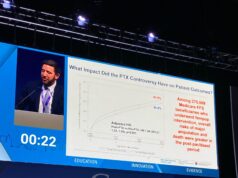
Three-year results from the ILLUMENATE Pivotal trial and the ILLUMENATE European randomised controlled trial (EU RCT) have been presented in a late-breaking trial session at the New Cardiovascular Horizons Annual Conference (NCVH; 29–31 May, New Orleans, USA) by S Jay Mathews (Bradenton Cardiology Center, Bradenton, USA). The data demonstrated a significant treatment effect with a high safety profile through three years following treatment with the Stellarex (Philips) sirolimus drug-coated balloon (DCB), with no significant difference in mortality compared to plain percutaneous transluminal angioplasty (PTA).
The two trials a are part of a series of five trials evaluating the safety and efficacy of Stellarex .035″ low-dose DCB to restore and maintain blood flow in the superficial femoral artery and popliteal arteries of patients with peripheral arterial disease. The results were evaluated compared to PTA treatment with uncoated balloons, the current standard of care.
Presenting the data, Mathews highlighted the following results:
- The ILLUMENATE Pivotal trial results show that at 36 months, 64.2% of the patients treated with DCB maintained blood flow through the treated segment of the diseased artery, compared to 51% of the patients treated with an uncoated balloon, demonstrating continued durability of the procedure.
- The ILLUMENATE Pivotal patient pool was the most complex studied in a randomised clinical trial. The pool included patients with the highest rates of comorbidities, such as diabetes and renal insufficiency, while 43.9% also had severely calcified lesions.
- The ILLUMENATE EU RCT results show that at 36 months, 67.5% of the patients treated with the DCB maintained blood flow (assessed through blinded core-lab adjudicated patency), compared to 59.9% of the patients treated with PTA.
- Through three years, both studies showed no significant difference in mortality compared to treatment with uncoated balloons. The mortality rate of patients treated with Stellarex in the ILLUMENATE Pivotal trial was 10.1%, compared to the mortality rate of patients treated with an uncoated balloon of 11%. The EU RCT showed mortality rates of 9.4% for patients treated with the DCB, compared to 8.5%for patients treated with PTA.
“The three-year data of the ILLUMENATE Pivotal trial and ILLUMENATE EU RCT add to the robust and consistent multi-year data of the Stellarex program,” Mathews said. “The demonstrated durability of Stellarex in the complex patient pool of the ILLUMENATE Pivotal trial, which are patients that are at high risk for restenosis, a recurring blockage, is unique in the industry. Moreover, we continue to see no significant difference in mortality rates between patients treated with Stellarex and those treated with uncoated balloons, which confirms our confidence in the safety profile.”
The results follow a data release from a pooled analysis of 2,300 patients’ patient-level data, presented earlier this year. Sean Lyden (Cleveland, USA) and Fabrizio Fanelli (Rome, Italy) discussed these data with Vascular News at the Leipzig Interventional Course (LINC; 22–25 January, Leipzig, Germany). Watch the video discussion here.













